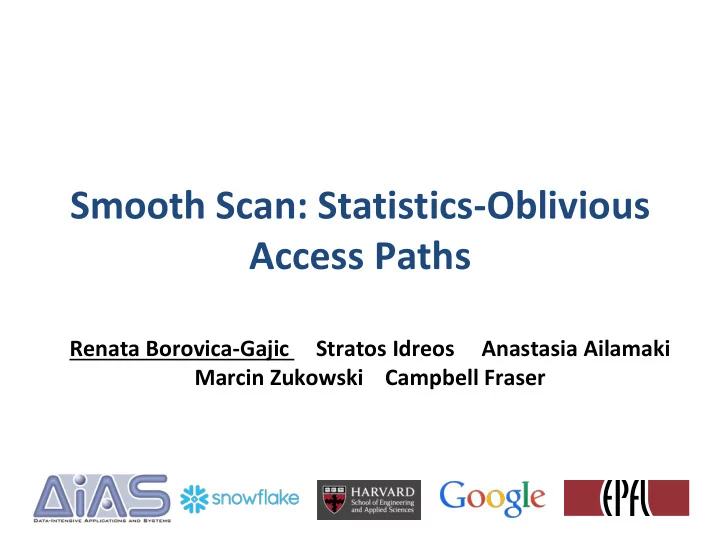

Smooth Scan: Statistics-Oblivious Access Paths Renata Borovica-Gajic Stratos Idreos Anastasia Ailamaki Marcin Zukowski Campbell Fraser
Optimizers’ sensitivity to statistics Setting : TPC-H, SF10, DBMS-X, Tuning tool 5GB space 1000 400 Normalized exec. time Tuned Original 100 (log) 10 1 0.1 Q1 Q2 Q3 Q4 Q5 Q6 Q7 Q8 Q9 Q10 Q11 Q12 Q13 Q14 Q16 Q18 Q19 Q21 Q22 TPC-H Query Degradation due to sub-optimal access paths 2
Access path selection problem Index Scan Re-optimization [MID’98, POP’04, RIO’05, BOU’ 14] Full Scan Execution time Performance cliff Full Scan RISK 0 100% Estimated Selectivity Actual Statistics: unreliable advisor Re-optimization: risky 3
Access paths under looking glass INDEX ... HEAP PAGES Index Access Sequential Access + read what you need + (fast) sequential I/O - random (& repeated) I/O - read everything No single path is optimal 4
Quest for robust access paths Index Scan Full Scan Execution time Robust Execution Full Scan RISK 0 100% Selectivity Near-optimal throughout entire selectivity range 5
Smooth Scan in a nutshell • Statistics-oblivious access path • Learn result distribution at run-time • Adapt as you go DESIGN GOALS • Avoid performance cliffs & risk • Continuous, gradual and smooth adaptation 6
Adaptivity with Smooth Scan Morph between Index and Sequential Scan 7
Morphing mechanism • Modes: 1. Index Access: Traditional index access 2. Entire Page Probe: Index access probes entire page 3. Gradual Flattening Access: Probe adjacent region(s) INDEX ... HEAP PAGES Mode 1 Mode 2 Mode 3 8
Morphing policies • Policies: Selectivity increase -> Mode Increase SEL_region > SEL_global – Greedy Selectivity decrease -> Mode Decrease – Selectivity Increase Driven SEL_region < SEL_global – Elastic INDEX X: Page with result SR: Region selectivity SG: Global selectivity HEAP PAGES X XX X X X XX X X X X X X XX SR:1 SR:1 SR:0.5 SR:0.75 SR:1 SR:1 SR:0.5 SG: 0 0.66 0.7 1 0.81 0.75 Region snooping = Selectivity driven adaptation 9
Smooth Scan benefits Index Scan Full Scan Sort Scan Smooth Scan Avoid repeated accesses Fast sequential I/O Avoid full table read Tuples pipelining 10
Experimental setup Hardware: 2 Intel Xeon 6-core CPU @2.8 GHz, 48GB RAM HDD: I/O transfer rate 120 MB/s, Random vs. Sequential ratio = 10 Software: PostgreSQL 9.2.1: Index Scan, Full Scan, Sort (Bitmap) Scan, Smooth Scan Workload: TPC-H: SF 10 Micro-benchmark: 400M tuples, 10 columns random (1 – 10 5 ), 25GB Q1: select * from relation where c2 >= 0 and c2< X% [order by c2]; Experimental Condition: Cold file system cache 11
TPC-H with Smooth Scan Setting : TPC-H, SF10, PostgreSQL with Smooth Scan 1400 High selectivity Low selectivity 10x 1200 Execution time (sec) 1000 800 600 400 15% 200 0 Q1 (Sort Scan) Q4 (Full Scan) Q6 (Index Scan) Q7 (Index Scan) Q14 (Index Scan) PostgreSQL PostgreSQL with Smooth Scan Robust execution for all queries 12
TPC-H breakdown Q1 Q4 Q6 Q7 Q14 pSQL Smooth S. pSQL Smooth S. pSQL Smooth S. pSQL Smooth S. pSQL Smooth S. # I/O Requests (K) 70 77 224 235 566 95 745 124 416 87 1200 CPU Utilization 1000 Execution time (sec) I/O Wait time 800 600 400 200 0 pSQL pSQL w. pSQL pSQL w. pSQL pSQL w. pSQL pSQL w. pSQL pSQL w. Smooth Smooth Smooth Smooth Smooth Scan Scan Scan Scan Scan Smooth Scan significantly decreases I/O wait time Q1 (Sort Scan) Q4 (Full Scan) Q6 (Index Scan) Q7 (Index Scan) Q14 (Index Scan) 13
Snooping I/O access Setting : TPC-H, Q1, Lineitem table, iosnoop tool Sequential Scan Index Scan Smooth Scan Block address Time (sec) Time (sec) Time (sec) Smooth Scan reduces random I/O requests 14
Adaptivity over selectivity range Setting : Micro-benchmark, Q1 (w. and w/o. order), Selectivity 0-100% 100000 100000 NO ORDER BY ORDER BY 115x 10000 10000 Execution time (sec) 1000 1000 Execution time (sec) 100 100 Robust Execution Robust Execution Full Scan 10 10 Full Scan Index Scan Index Scan 1 1 Sort Scan Sort Scan Smooth Scan Smooth Scan 0.1 0.1 0 0.001 0.01 0.1 1 20 50 75 100 0 0.001 0.01 0.1 1 20 50 75 100 Selectivity(%) Selectivity(%) Near-optimal performance throughout entire range 15
Conclusions SMOOTH SCAN • Statistics-oblivious access path • Uses region snooping to morph between alternatives • Near-optimal performance for all selectivities IMPACT • Removes access path selection decision • Robust execution for all query inputs 16
Q & A renata.borovica@epfl.ch stratos@seas.harvard.edu natassa@epfl.ch marcin@snowflake.net campbellf@google.com Thank you!
Recommend
More recommend